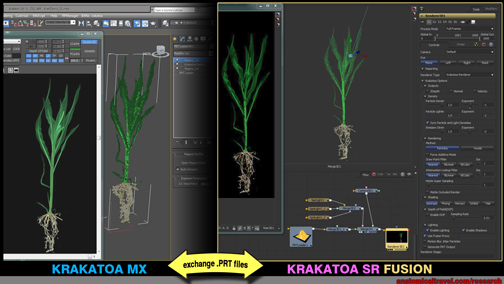Krakatoa creates either points or voxels for particle data for greater VFX utility. Python and C++ linking to other programs opens up new rendering options.
This week Thinkbox Software releases Krakatoa SR, a stand-alone version of its high-volume CPU-based particle renderer. Krakatoa has become popular for high-energy special effects for large scenes involving flowing water, smoke, and other high-volume particle effects.

Previously available for Autodesk 3ds Max and Autodesk Maya 3D software, Krakatoa is CPU-based, highly optimized, heavily multi-threaded, and usable on most hardware running Windows or Linux operating systems, including laptops and render nodes, without dedicated high-end graphics accelerators. Krakatoa SR exposes both a Python-based interface and a C++ API to connect to various professional 3D applications such as Nuke or Houdini.
Key features of Krakatoa SR include:
- Point or voxel representation of particle data, with various filter modes, motion blur and depth of field camera effects, and HDRI render passes output to OpenEXR files
- Support for both additive and volumetric shading models at the same time, with per-particle control over color, emission, absorption, density and more
- Support for various light scattering algorithms, high-quality self-shadowing and occlusions from both geometry and DTEX maps
- Particle loading of Krakatoa .PRT file sequences, RealFlow .BIN file sequences and .CSV file sequences, with the ability to offset, retime, combine and modify already cached particles
- Procedural particle creation from polygon mesh volumes and mathematical algorithms
- Particle repopulation for render-time conversion of low-count simulations into high-count particle clouds.

“Integrating Krakatoa SR with our existing toolset was easy and we were able to get it rolling without much effort,” says Arun Ramasamy, Software Engineer, Anatomical Travelogue, an award-winning creator of high-end 3D visualizations based on human data. “We received constant support from the Thinkbox development team and it worked so well that we are developing Krakatoa into a functional particle rendering pipeline inside eyeon Software’s Fusion.?
Ambient Entertainment is using Krakatoa SR for work on the upcoming animated film Tarzan, which is scheduled for release in 3D later in 2013. “When we switched our fluid pipeline to Naiad for Tarzan, we had been searching for a way to do high quality particle rendering and were extremely excited to get our hands on Krakatoa SR,” says Haggi Krey, Ambient visual effects supervisor. “We were able to implement Krakatoa SR based on the open source OpenMaya framework and Partio library, and now we can read any particle system from almost any software and render in Krakatoa. Without Krakatoa, it would be impossible to get the required quality on some of our shots.”
Thinkbox says Krakatoa SR is compatible with the network rendering licenses used by the other Krakatoa implementations (Krakatoa MX and Krakatoa MY).





